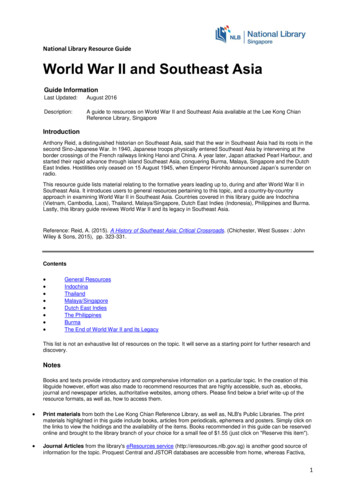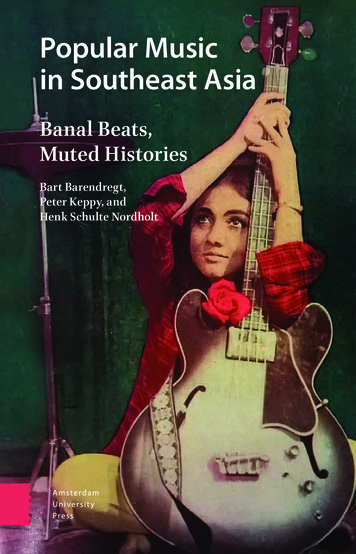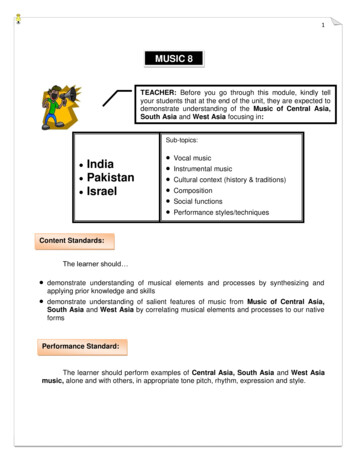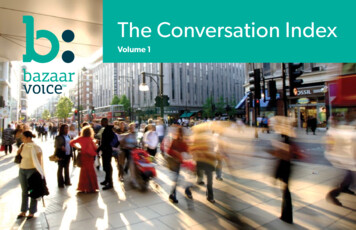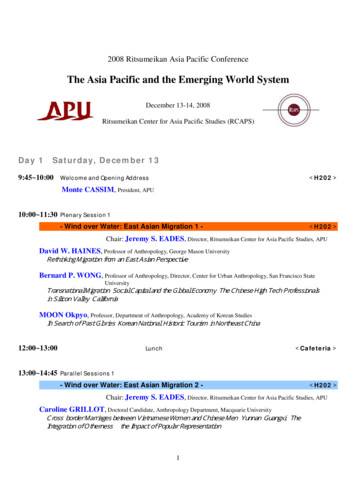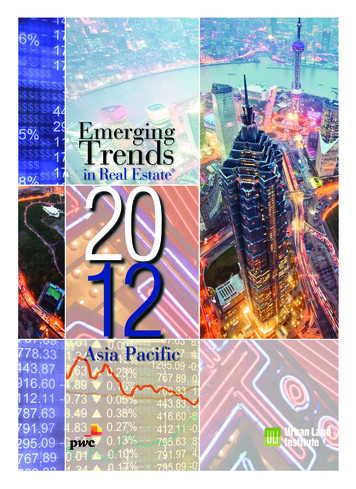
Transcription
Understanding Southeast Asia’sEmerging Middle ClassDigital opportunities give consumers many more choices.
Florian Hoppe and Aadarsh Baijal are partners with Bain & Company’s Digital practice. They arebased in Singapore.This work is based on secondary market research, analysis of financial information available or provided to Bain & Company and a range of interviewswith industry participants. Bain & Company has not independently verified any such information provided or available to Bain and makes no representationor warranty, expressed or implied, that such information is accurate or complete. Projected market and financial information, analyses and conclusionscontained herein are based on the information described above and on Bain & Company’s judgment, and should not be construed as definitive forecastsor guarantees of future performance or results. The information and analysis herein does not constitute advice of any kind, is not intended to be used forinvestment purposes, and neither Bain & Company nor any of its subsidiaries or their respective officers, directors, shareholders, employees or agents acceptany responsibility or liability with respect to the use of or reliance on any information or analysis contained in this document. This work is copyright Bain &Company and may not be published, transmitted, broadcast, copied, reproduced or reprinted in whole or in part without the explicit written permissionof Bain & Company.Copyright 2019 Bain & Company, Inc. All rights reserved.
Understanding Southeast Asia’s Emerging Middle ClassNguyen Thi Mai Linh was forced to drop out of school but now juggles motherhood and a flourishingonline cosmetics business from her home in Hai Phong, Vietnam. After putting her young child to bedat night, Nguyen spends another hour responding to messages from her customers, tracking competitors’products and prices, and keeping up with beauty trends. She says she is proud that she can now affordto buy baby formula and diapers for her child.In Surabaya, Indonesia, Fadli is living his dream by selling cookies online. In Bucalan, Philippines,Randy left teaching to become an app-hailing driver so that he could boost his income and devotemore time to his wife and daughter. In Johor Bahru, Malaysia, a 25-year-old truck driver named Shahansupports his parents and seven siblings back home in his village—but spends his weekends on biketours with friends he made from online biking communities. In Khon Kaen, Thailand, 35-year-old Ongwanted to be her own boss—so she became an online reseller of coffee and then started a successfuldog-breeding business.Ready or not, a huge middle class is emerging throughout developing Southeast Asia. Fueled by therising incomes that result from hard work and ambition, 50 million new consumers will join the ranksof the middle class in Indonesia, Malaysia, the Philippines, Thailand and Vietnam by 2022, contributingto the region’s 300 billion middle-class disposable income. The middle class will expand to include350 million people and continue on its upward trajectory. It is propelled by greater access to the flourishing digital economy and a view of the broader online world outside their visible community, and bythe lasting positive effect that happens when people move out of poverty and watch their communityof neighbors, family and friends achieve their dreams—and see the possibilities for themselves. Alsocontributing to this expansion of the middle class are various ASEAN pacts aimed at regional economic integration.To understand the evolving opportunities and the impact this phenomenon will have on companies, wespoke with 40 business leaders across industries throughout the region. While 77% say this new groupof middle-class consumers could help them significantly grow their business, only 15% of those executivesindicated that they are fully prepared for them. More than half of the executives say they lack the rightproducts or services, as well as go-to-market strategies and sales channels for these consumers. Fully60% say they lack a clear marketing strategy (see Figure 1).How this market is differentThese findings led Facebook and Bain to collaborate on an extensive research project to learn aboutSoutheast Asia’s emerging middle class from every possible angle. That included 80 in-home interviewsacross the region and 160 peer hangouts. Separately, Bain surveyed 12,000 digital consumers acrossthe region. The research provided a deep profile of Southeast Asia’s newest consumer segment, whichis quickly evolving with expanded digital access. We learned who they are and the issues they face, asthey struggle with—and grow from—the mounting tension between their traditional environment andone that is broadened with new digital access to sources of information, communities and services.Our research enabled us to take a first step toward helping companies determine how best to serve thisexploding market of consumers.1
Understanding Southeast Asia’s Emerging Middle ClassFigure 1: How prepared are business leaders for Southeast Asia’s emerging middle class?77% say this new group of middle-class consumers could help them significantly grow their business.15% of those executives indicated that they are prepared for them.54%of the executives say they lack the right products or services as well as go-to-marketstrategies and sales channels for these consumers.60% say they lack a clear marketing strategy.Source: Bain & Company survey of Southeast Asia business leaders, (n 40)Just as consumers in developing Southeast Asia grapple with the tug of war between traditional andmodern cultures, companies face a similar challenge. Many have traditionally grown their businesses byfocusing on affluent or upper-middle-class consumers in narrow urban corridors. Now, they must learnhow to reach and appeal to a new group of consumers with distinctly different profiles, consumptionhabits and media behaviors.Among the many changes: Southeast Asia’s middle class is far more dispersed than many businessleaders realize. Increasingly, they reach across urban and rural settings. While much of the growth takesplace in the capitals of Jakarta, Bangkok, Kuala Lumpur, Manila and Ho Chi Minh City, an equal numberof households are joining the middle class from the region’s Tier-2 cities—places like Ambon andSamarinda in Indonesia, Chanthaburi and Lop Buri in Thailand, Imus and Santa Rosa in the Philippines,Can Tho and Thu Dau Mot in Vietnam, and Alor Setar and Kota Kinabalu in Malaysia.Moreover, many executives still hold notions that this segment comprises unsophisticated consumerswho are highly cost-driven, shop primarily in traditional channels and favor inexpensive sachet packages designed for low-income shoppers. They see them as primarily influenced by word of mouth, orby TV and other traditional channels of communication. The reality is that the digital era has broughtwith it not only a change in consumption behavior but new and evolving influences. These and othermisconceptions create challenges for companies hoping to grow along with Southeast Asia’s risingmiddle class.2
Understanding Southeast Asia’s Emerging Middle ClassA world of new choicesThe emerging middle class is embracing the online world and taking full advantage of the greateropportunities that come with digital exposure. As a result, their growing ranks are rapidly changingthe game in all industries.As they increase their digital usage, these consumers widen their worldview beyond the limits of work,neighborhoods or traditional expectations. They now enjoy a huge privilege that previous generationsdid not: greater power to choose. They can choose the person they want to be, the people they want tobe with and the passions they want to follow.Our interviews across the region helped us identify four common themes.1. Power to choose identitiesToday’s emerging middle-class consumers are able to define their own modern identity through thepower of digital connectivity, while still maintaining strong ties to their traditional cultural backgrounds.These blended identities allow them to express and shape new points of view.“The benefit of having this business is that I can go on vacation withoutaffecting my family’s finances. It’s important to have priorities in life. Forme it’s my family and my child.”NindaMalang, IndonesiaBeing a mother to a three-year-old girl does not stop Nindafrom pursuing her ambition of running her own Muslim fashionbusiness. Ninda opened an online shop as well as a physicalstore, all while juggling her duties at home.Ninda explains that owning the shop gives her an identity beyondthat of a wife, mother and daughter. She’s been savvy in usingdual online and offline strategies to bring in new foot traffic toher brick-and-mortar clothing store and at cross-promoting herclothes on social media and online marketplaces. She knowsthat the key to success is to be persistent and to keep a lookout for what will interest her customers the most. She achievesthis by being active on multiple social platforms and followingfashion influencers.3
Understanding Southeast Asia’s Emerging Middle ClassRandyBucalan, PhilippinesIt wasn’t a tough decision when Randy made the switch fromteaching to becoming an app-hailing driver. Now he has moreincome and flexible working hours that allow him to spend moretime with his wife and daughter.Thanh NgaCan Tho, VietnamThanh Nga may still be a student, but she already has startedseveral online ventures selling products that she sees trendingon social media. Running these businesses gives her confidenceand independence. Her hope is that one day she will be viewedas an experienced and successful businessperson.2. Power to choose communitiesDistance does not stand in the way for members of Southeast Asia’s emerging middle class. Our researchillustrates how online communities bring people together, uniting those with shared passions, aspirationsand challenges. These online communities function as support systems that influence members’ behaviors, attitudes and perspectives, opening up the world beyond their village community, or kampong.FrenalynDavao City, PhilippinesFriends helping friends. That is the simple philosophy behindFrenalyn’s approach to supporting her fellow moms. As a motherof two children (with a baby on the way), she has benefitedfrom the advice she has received from online communities andparenting apps. Now, she is dedicating herself to giving back.For example, when one mother needed help feeding a babywith a cleft palate, Frenalyn was able to connect her to a friendwho could recommend a breast pump.4
Understanding Southeast Asia’s Emerging Middle ClassHienBac Ninh, VietnamHien works as a cashier at a local Korean restaurant andconsiders herself to be the ultimate fan of Korean culture.Thanks to a proliferation of social media groups and onlinevideos, she was able to teach herself the Korean languageand advance toward her goal of working for a popularKorean technology brand.3. Power to choose dreamsThe pursuit of personal passions, long considered a luxury in developing Southeast Asia, is now notonly possible but is also celebrated. Digital exposure is helping to raise members of the emerging middleclass above their socioeconomic status. It spurs brand awareness and the desire to travel. It allows themto project a better image of themselves and to pursue passions far outside of traditional pathways.FadliSurabaya, IndonesiaGrowing up, Fadli always wanted to attend culinary school, buthis parents discouraged the idea, viewing it as an unconventional dream for an Indonesian man. However, his passion forthe culinary arts never faltered. Despite the time constraints ofhis day job in marketing, he started learning baking techniquesfrom his wife. Together, they launched a thriving cookie-bakingbusiness, which the couple promote on social media to a rapidlygrowing community of followers.ElynJohor Bahru, MalaysiaAs a working mother with two young boys, Elyn is not satisfiedwith her day job at a real estate company, so she pursues herafter-hours passion of selling clothes online. Her motivationstems from wanting to generate enough income to not need torely on her husband. The business has enabled her to buy ahigh-end refrigerator.5
Understanding Southeast Asia’s Emerging Middle ClassOngKhon Kaen, ThailandAfter leaving her previous job, Ong felt restless. Yearning for thefinancial independence she previously enjoyed, she decidedto embark on online entrepreneurship. Her first venture was tobecome a reseller of coffee, which she actively promoted online.Since then, she has launched other new businesses, includingdog-breeding and transportation services. The online worldgives Ong possibilities that were previously available onlyto big companies: She can swiftly jump on opportunitiesas they emerge, and quickly test and learn without a bigfinancial commitment.4. Power to choose joyOur findings reveal that members of Southeast Asia’s emerging middle class have become moresophisticated in what they buy, and how they buy it. Exposure to digital marketplaces and social mediasites has led them to seek out and purchase whatever brings them joy—whether it is travel, cosmetics,new experiences or branded goods. They use social media to elevate their sense of confidence andtheir sense of status and to display their achievements.CuongCan Tho, VietnamAs a rice trader, 25-year-old Cuong works seven days a weekin the business he runs with his brothers. As the business hasgrown, his life has become more hectic. Cuong feels that hedeserves time to de-stress. This notion of taking time off isalien to his parents’ traditional point of view. He has been savvyenough to save money to take short trips with his fiancée toplaces that he’s learned about online.“I travel to the nearby islands. I also go for some long trips. Get togetherwith friends and plan. It helps to change the air and atmosphere. It isa new environment and you feel refreshed.”6
Understanding Southeast Asia’s Emerging Middle ClassJay Paul FaustinoDavao, PhilippinesJay’s greatest joy comes from skateboarding. When he is notat his call-center job, he creates videos of himself and his friendsskateboarding, to publish on his own channel. Jay recentlybought a brand of sneakers that was endorsed by Riley Hawk,a famous skateboarder he follows on social media.How to sell to Southeast Asia’s emerging middle classNew choices for consumers means new choices for companies. Our research has helped us identifythe fundamental decisions that companies can make to grow along with Southeast Asia’s emergingmiddle class:Choose productsWinning brands are outpacing their rivals by simultaneously appealing to middle-class consumers’desire for new experiences while understanding how these consumers are caught between theirheritage and kampong upbringing and the modern world. These companies also take advantage ofthe increasingly sophisticated pockets of demand for high-end products which are spread out over ahuge region. And they rely on technology to help serve this demand. Indeed, their businesses flourishin Southeast Asia because they sell online, as opposed to going the expensive alternative route ofstocking offline stores.This approach has helped spur the success of a host of companies. Indonesia’s GarudaFood is growingby constantly innovating and introducing more premium products—developing new biscuit flavors,for example. It recently launched a highly successful green tea latte product exclusively on Tokopedia.Wardah is an Indonesian cosmetics company that achieved phenomenal growth by focusing on halalbeauty products. It initially targeted ambitious, modern hijabis, but has expanded to gain popularityamong those who don’t wear the garment. For its efforts, Wardah has captured 30% share of the makeup market in Indonesia.Choose pathsSoutheast Asia’s emerging middle-class consumers are aspirational, “lean-forward” audiences. Successful brands can create a lot of pull by engaging well with digital communities (e.g., diaper websites) andby catching these consumers on the move. Also, it’s possible to target them very granularly for their more7
Understanding Southeast Asia’s Emerging Middle Classdifferential spending patterns. In Malaysia, FashionValet boosted conversion rates when it used exitintent technology and behavior targeting to appeal to a segment of visitors to the FashionValetMalaysia site. The best brands tend not to rely solely on passive channels—but if they do, they captureconsumers during mobile moments. Pond’s accessed more than 12 million women through its locationbased campaign that spoke to young women commuters on the dangers of pollution to their skin. Thecampaign helped contribute to 5% revenue growth for Pond’s.Choose channelsBrands need to move beyond traditional offline and online channels. Often, that means social commerceplays a role, beyond major e-commerce sites. Thai fashion purveyor Hamburger Studio has achieved100% annual growth by promoting its products on mobile commerce platforms and offering engagingand visually immersive mobile experiences. Brands also invest in offline setups to create true experiences for targeted consumers. In Thailand, Pomelo came to life as an online fashion site but now hasidentified 800 locations for potential micro-retail stores in which customers can experience the productsbefore buying.As Southeast Asia’s middle class grows along with digital capabilities, companies have a unique opportunity to reach a vast new community of consumers just as they are gaining exposure to differentbrands and developing preferences. The steps that consumer goods companies take today will shapeconsumers’ choices for the decades ahead.8
Shared Ambition, True ResultsBain & Company is the management consulting firm that the world’s business leaders cometo when they want results.Bain advises clients on strategy, operations, technology, organization, private equity and mergers andacquisitions. We develop practical, customized insights that clients act on and transfer skills that makechange stick. Founded in 1973, Bain has 57 offices in 36 countries, and our deep expertise and clientroster cross every industry and economic sector. Our clients have outperformed the stock market 4 to 1.What sets us apartWe believe a consulting firm should be more than an adviser. So we put ourselves in our clients’ shoes,selling outcomes, not projects. We align our incentives with our clients’ by linking our fees to their resultsand collaborate to unlock the full potential of their business. Our Results Delivery process builds ourclients’ capabilities, and our True North values mean we do the right thing for our clients, people andcommunities—always.About Facebook IQRooted in what we’ve learned from 2 billion people on our platforms and the 6 million businesses thatadvertise with us, Facebook IQ provides actionable insights about people, marketing and measurement.We offer studies, tools and resources built to transform how marketers reach people and deliver realresults in this crosschannel, multi-device world. Whether you need inspiration for your next big idea,research on how best to reach the people that matter most, or the latest in ad effectiveness, lean onFacebook IQ for insights and strategies.To learn more, please visit www.facebook.com/iq
For more information, visit www.bain.com
Understanding Southeast Asia's Emerging Middle Class 6, Cuong Can Tho, Vietnam, As a rice trader, 25-year-old Cuong works seven days a week in the business he runs with his brothers. As the business has grown, his life has become more hectic. Cuong feels that he deserves time to de-stress.
